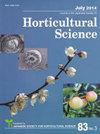Incidence of Blossom-end Rot in Relation to the Water-soluble Calcium Concentration in Tomato Fruits as Affected by Calcium Nutrition and Cropping Season
Journal of The Japanese Society for Horticultural Science
Pub Date : 2014-07-04
DOI:10.2503/JJSHS1.CH-107
引用次数: 16
Abstract
To understand the factors affecting the incidence of blossom-end rot (BER), the effect of the Ca/K ratio (4/12– 12/4, in me·L–1) in nutrient solutions and Ca concentration in fractions in the distal part of young tomato fruits immediately before BER symptoms appear were investigated for three seasons. The rate of BER incidence increased with a decrease in the Ca/K ratio in the supplied solutions in the summer and spring, but little difference was observed in the winter. Ca concentration was highest in winter and lowest in summer, and the concentration in fractions decreased with a decrease in the Ca/K ratio of the solutions. When the results of all three experiments were pooled, among the fractions, water-soluble Ca concentration was found to have the highest significance in the relationship to BER incidence. The risk of BER incidence in rapidly growing tomato increased to a critical level when water-soluble Ca in the distal part of the fresh fruit decreased to less than 0.20 μmol·g–1 FW. Multiple-regression analysis revealed that the concentration of water-soluble Ca, which is predominantly recovering apoplastic or cytoplasmic Ca2+, and total Ca, which has been translocated during fruit development, are significantly affected by solar radiation and Ca concentration in the supplied solution rather than air temperature.钙营养和种植季节对番茄果实水溶性钙含量的影响
为了解影响花端腐病发病的因素,研究了3个季节中营养液Ca/K比(4/12 ~ 12/4,在me·L-1中)和番茄幼果末端部分Ca浓度对花端腐病发病的影响。在夏季和春季,随供液Ca/K比的降低,BER的发生率增加,但在冬季差异不大。Ca浓度冬季最高,夏季最低,各组分浓度随溶液Ca/K比的降低而降低。将三个实验结果汇总后发现,水溶性Ca浓度对BER发病率的影响最为显著。速生番茄鲜果远端水溶性Ca低于0.20 μmol·g-1 FW时,BER发病风险达到临界水平。多元回归分析表明,在果实发育过程中,主要恢复外胞体或细胞质Ca2+的水溶性Ca浓度和在果实发育过程中转运的总Ca浓度受太阳辐射和供液中Ca浓度的影响显著,而温度对其影响较小。
本文章由计算机程序翻译,如有差异,请以英文原文为准。
求助全文
约1分钟内获得全文
求助全文
来源期刊
自引率
0.00%
发文量
0
审稿时长
>36 weeks

 求助内容:
求助内容: 应助结果提醒方式:
应助结果提醒方式:


